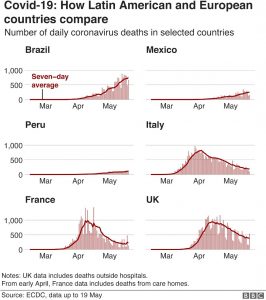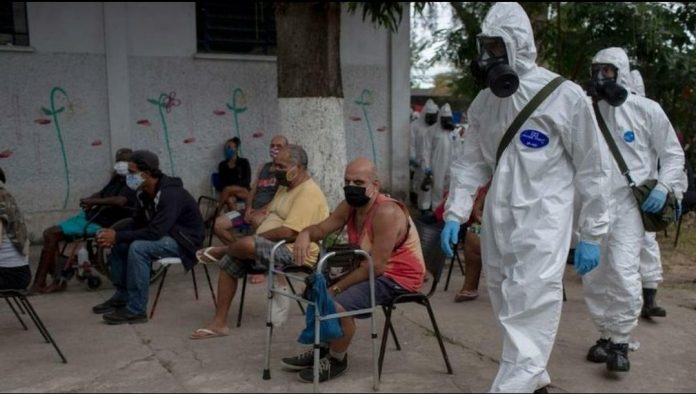By Jake Horton (BBC Reality chek)
International, Legion News.com “Coronavirus cases have been rising sharply in many Latin American countries, causing increasing concern to regional health authorities”.
Brazil has more than 370,000 confirmed cases – the second highest in the world.
Other countries in the region, including Mexico, Chile and Peru, are also struggling to contain major outbreaks.
With new confirmed cases in the US plateauing and many European countries reporting declining numbers, is Latin America the new epicentre of the pandemic?

The first confirmed case in Latin America was identified in Brazil on 26 February, although researchers have said there are indications that there were cases there as early as January.
This is far fewer cases and deaths than in Europe and the US, but testing is nowhere near as widespread and deaths may be under-reported.
Latin America’s two most populous nations, Mexico and Brazil, have seen the highest number of deaths, more than 7,000 and 23,000 respectively.
And researchers say both could be significantly under-reporting deaths, with many cases going undiagnosed.
Peru has reported the 12th highest number of cases in the world with more than 120,000 confirmed – which is more than China.
And Chile is reporting thousands of new coronavirus cases each day, with more than 700 people dead.
Ecuador has seen the most deaths per capita in the region – with around 19 per 100,000 people. Daily cases in Ecuador have been stabilising, but this is not the trend in many other countries in the region.
Peak not yet reached
Unlike in the US and most countries in Europe, many countries in Latin America are seeing their daily cases and deaths increase.
Looking at Brazil, Mexico and Peru compared to the worst hit countries in Europe in terms of deaths – the UK, Italy and France – you can see daily deaths are growing in Latin American nations as they drop elsewhere.

The number of deaths in Brazil, Mexico and Peru is doubling roughly every two to three weeks, as opposed to about every three months in the UK, four months in France, and six months in Italy.
Deaths in the US are doubling about every two months.
On 22 May, the World Health Organization’s emergencies director, Dr Mike Ryan, said: “In a sense, South America has become a new epicentre for the disease.”
This came as Latin America – including Central America and Mexico – surpassed the US and Europe in reported daily cases.
And experts say the peak of the epidemic in some Latin American countries is still some weeks away.
As daily cases continue to rise, there are concerns that healthcare systems could be overwhelmed, as has already been the case in Ecuador.
Chile’s healthcare system is “very close to the limit”, according to President Sebastián Piñera.
And Pilar Mazzetti, who is leading of the Peruvian government’s coronavirus response, has said: “We’re in bad shape. This is war.”
What is being done to stop the spread?
Mexico and Brazil have continued to take less severe lockdown measures than other Latin American countries.
Both have given out guidelines, but have not imposed national restrictions.

Brazil’s President Jair Bolsonaro has repeatedly downplayed the virus.
Marcia Castro, a global health professor at Harvard University, says that “the response in Brazil is far from ideal, and currently there is a lack of a uniform message coming from the leadership at different levels.”
Other countries such as Argentina have imposed compulsory lockdowns.
And Prof Castro says it is, along with Uruguay, among the countries in the region for now able to manage the spread.
Peru has had one of the first and strictest national lockdowns in the region, but continues to see cases and deaths rise.
As cases rapidly rise in Chile, the government has announced a mandatory lockdown in the capital Santiago.
Chile has one of Latin America’s highest rates of testing – 25 tests per 1,000 people.
But testing across the region is significantly below other parts of the world.
Brazil also has a low testing rate, and a study by the University of São Paulo Medical School estimates the number of infections could be about 15 times higher than the official figure in the country.
President Bolsonaro wants to begin reopening Brazil’s borders despite increasing infections, but other Latin American governments have expressed worries that the worsening situation there could have ramifications across the region. (**)



























